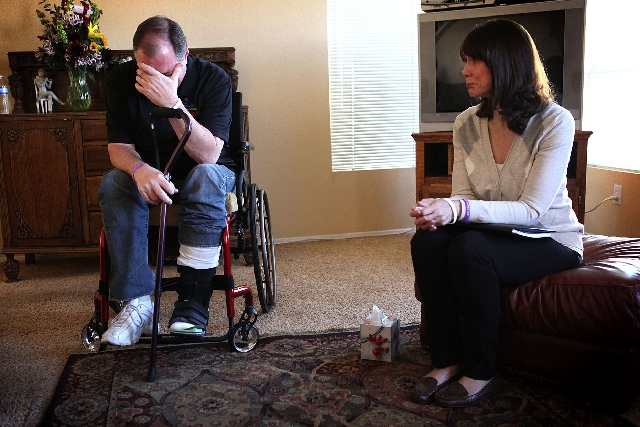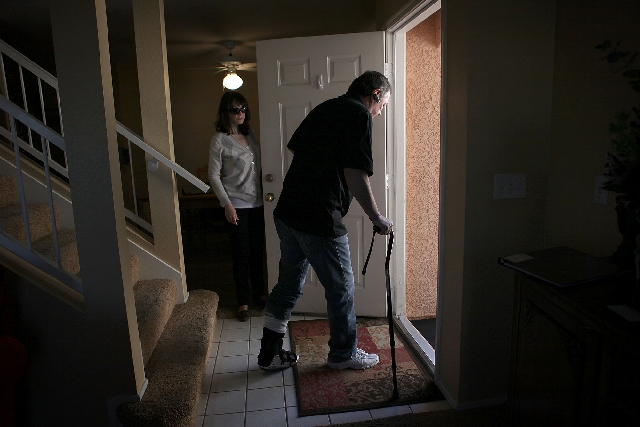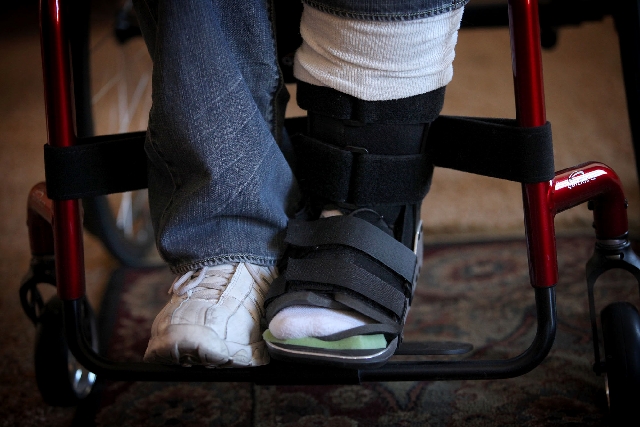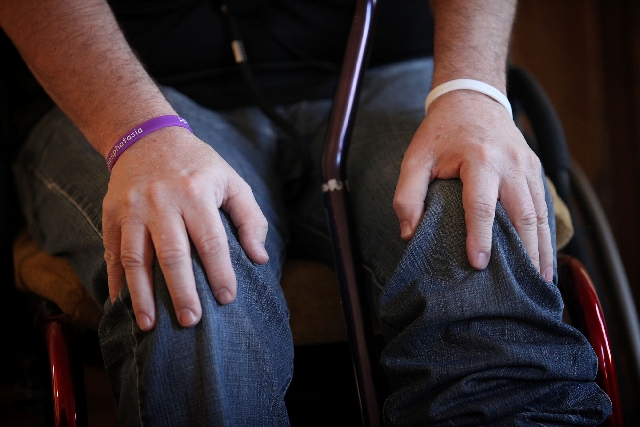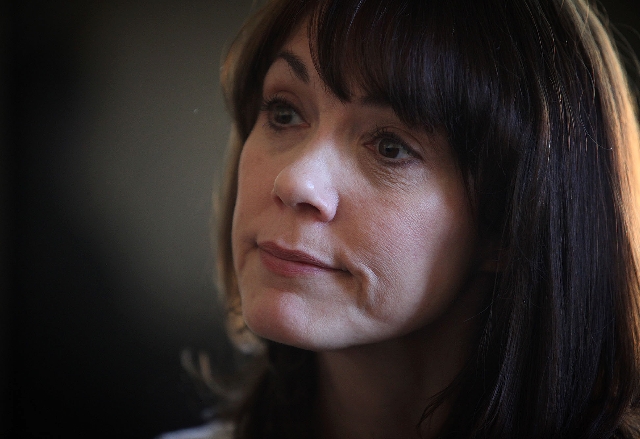Metabolic bone disease has Las Vegan fighting extreme pain
In the world of 53-year-old David Heaps, it makes sense to wear tennis shoes to bed.
Tied tightly, they frequently serve as a cocoon, smothering at least some of the agonizing sensation of bones splintering in his feet.
In the darkness, he prays for rest after a day of torment. Walking with a cane has resulted in tiny fractures in his ankles and feet and throbbing often moves up both legs, leaving him feeling as though his body below the waist is on fire.
His wife, Jennifer, recalls the so many times her husband has cried out for relief that a morphine patch or oxycodone will not bring.
“I hold his hand, but there is nothing I can do,” she said, weeping as she sat in an armchair in their northwest Las Vegas townhome. “I wish there was. There are times when I don’t know how long either of us can continue to take it.”
What’s made life for David and Jennifer Heaps hell on earth is an ultra-rare, life-threatening metabolic bone disease called hypophosphatasia. The disease that can have adult-onset, as it did for Heaps, but is often associated with children, half of whom die within one year of birth because the disorder often leaves them without a rib cage to protect their lungs.
Although researchers estimate HPP affects one in 100,000 births, there is no estimate of how many adults currently suffer with the genetic disorder. But it’s one of the 7,000 diseases that the world’s top health officials classify as rare. In the U.S., the Rare Disease Act of 2002 defines rare disease as “any disease that affects (fewer) than 200,000 people.”
The adult-onset form of HPP usually occurs in middle age with spontaneous or low trauma fractures of the weight-bearing parts of the human skeleton –– the feet, the legs and the pelvis.
Heaps began experiencing unexplained pain in his back and legs in 2009, but it took more than two years of visits to a variety of specialists before he received a diagnosis last March.
“What it finally took was a doctor here in Las Vegas to think outside the box,” said Heaps, who got up from his wheelchair and limped toward the kitchen with a protective boot covering one broken foot. Hyperventilating as tears streamed down his face, he apologized for his behavior. “I’m sorry, sometimes I feel as though someone hit me across my shins with a baseball bat.”
BEING REALISTIC
Late last year, in an effort to keep others from undergoing months of grueling diagnostic tests and to spur more research funding for the disease, Heaps and his wife began the HPP-Choose Hope Foundation in Las Vegas, the only organization affiliated with the disease that also zeroes in on the adult experience with the disorder. Physicians as well as the public can be educated about the disease at www.hppchoosehope.org.
In his Day in the Life section of his HPP website, Heaps wrote about how one day started:
“Getting out of bed I use my wrist and arm to push the weight of my body and then a sharp pain and I know my wrist is fractured. Just getting out of bed and you break bones. So today will be spent in emergency care getting my wrist taken care of. Just another day in the life with HPP.”
It is important, Heaps said, to give people a realistic look at a disease that fortunately gives him a few hours each day –– usually in the morning –– without pain.
“People need to know about this disease so something can be done about it,” said Heaps, who had to leave his marketing position with the Nevada State Corporate Network, which helps create businesses, because of his illness.
Often when he’s sure he’s broken more bones in his feet, ankles or lower legs, he no longer goes to the doctor.
“There’s really nothing they can do for the fractures anyway and too much radiation isn’t good for me.”
More than 95 percent of rare diseases, including HPP, have no therapy or drug treatment. The Orphan Drug Act of 1983, the federal law designed to encourage research into rare diseases and possible cures, has produced 326 new drugs approved by the Food and Drug Administration. Dispensing pain medication, however, is most often the best doctors can do.
DIFFICULT DIAGNOSIS
When Heaps showed up for an appointment at the office of Dr. Neil Braunstein, the local rheumatologist who initially saw Heaps for a possible severe form of arthritis, the physician had never diagnosed or seen HPP in his training.
“He was obviously in tremendous pain,” Braunstein said.
Though not seen on regular X-rays, small fractures were found in more sophisticated MRI imaging that the physician ordered after Heaps continued to complain about pain in his ankles. “Fractures like that aren’t something we usually see in arthritis cases.”
Heaps, who also complained of nausea that sometimes erupted into pain-induced vomiting, had seen at least a dozen doctors to find out what was wrong with him.
Braunstein found one constant in the all the tests –– low levels, though not abnormally so, of alkaline phosphatase in his blood.
“It was just me and the patient working together, dealing with pieces in a puzzle leading us to the next test,” the doctor said. “From what I had read, I thought HPP could be it.”
Braunstein sent Heaps to a rare- disease specialist at UCLA, who confirmed the diagnosis.
“We were relieved on the one hand, but then when they said there was no cure or treatment and they didn’t even know what his future would be like, that was hard,” Jennifer Heaps said.
Because of a genetic defect, people with HPP are deficient in an enzyme known as tissue nonspecific alkaline phosphatase. Without this enzyme, there are abnormalities in phosphate and calcium mineral metabolism, leading to destruction and deformity of bones, progressive damage to vital organs, debilitating muscle weakness, seizures, impaired renal function and respiratory failure.
“Doctors seems to be particularly worried about what the disease may be doing to my kidneys,” Heaps said.
Genetic testing showed he had the infant form of the disease, yet he never had symptoms as a child. At this point, he has found no evidence that his parents or grandparents or siblings had the disease and his grown children are also not showing symptoms.
Braunstein now believes HPP is underdiagnosed, an observation held by many researchers, who suggest genetic testing will show less severe cases of HPP are now considered under the diagnosis of osteoporosis.
The most severe, perinatal form of HPP starts in utero and usually causes death shortly after birth as the malformed and undermineralized rib cage of the child does not expand enough to allow normal lung function.
In the infantile form, which occurs before 6 months of age, the “soft bone” state eventually leads to spontaneous fractures and failures in those areas of the skeleton that are most challenged to perform, such as the chest wall with breathing.
The childhood form of HPP hits before age 5, causing premature loss of baby teeth, growth retardation and skeleton deformity.
SEARCHING FOR HOPE
Last year, a new therapy gave hope to parents of children with HPP, with the drug asfotase alfa replacing the missing enzyme during a study done by the Washington University School of Medicine and Shriners Hospitals for Children.
That small study of 11 babies and children younger than 3 who had debilitating or life-threatening HPP found the medication strengthened bones and improved lung function. After 48 weeks of treatment, many could start bearing weight on their legs, with some infants even taking their first steps.
The drug treatment needs to be ongoing and it’s not yet clear if there are long-term side effects –– children that were in the study will be closely monitored. Researchers have found the new treatment promising with further studies expected to start soon.
Heaps can’t help but wonder if the drug could help him as well.
“Hopefully, I will get to try it,” he said.
Jennifer Heaps, 48, prays that she and her husband can hold on until something positive happens with his condition and that he’ll soon be awarded Social Security Disability.
“It’s not going to be easy financially or emotionally,” she said. “We’ve been living on savings and help from friends and that’s about to run out. Sometimes I think I can handle this and other times I can’t. He’s 6 foot, 200 pounds and I don’t know what I’ll do if it gets to the point where he can’t dress or take care of himself.”
After 15 years, she lost her job with an insurance company in 2012 and she’s been unable to land another office job. Her unemployment insurance is about to run out. When that happens, they will no longer be able to afford the expensive COBRA continuation medical insurance that costs almost $500 a month to cover David. The couple is now checking to see whether David can receive coverage under the Affordable Care Act of 2010.
The Heaps met over the Internet about four years ago. Both were single parents who had successfully raised their children. At the time, David worked in Salt Lake City and would often travel to Las Vegas to visit Jennifer.
They had looked forward to traveling together both stateside and abroad.
“He would complain of pain but I just that was from all the traveling,” she said.
They were married only a year when the HPP diagnosis was made.
As a wave of pain hits, Heaps bends over in his wheelchair, sobbing. Jennifer Heaps, tears welling in her eyes, chokes up.
“He says he’s actually lucky,” she said. “He says he had the infant form of this disease but he got 50 years in before it got him.”
Contact reporter Paul Harasim at
pharasim@reviewjournal.com or 702-387-2908.



